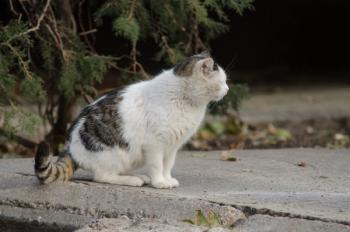
Journal Scan: Give vomit the ol heave-ho in cats receiving anesthetics and pain medications
A recent study on the effects of maropitant in cats suggests it could help prevent vomiting when taken before dexmedetomidine and morphine, with one major caveat.
(Getty Images)Vomiting is a common adverse effect associated with certain anesthetic and pain medications and is unpleasant for both veterinary teams and their patients. It occurs in about 80 percent of cats given dexmedetomidine, buprenorphine, hydromorphone or xylazine.1-3 Common antiemetics, like ondansetron and metoclopramide have been used to decrease the incidence of emesis, but a third of cats still vomit with these treatments.1
Sick study design
This study was designed to examine the antiemetic effects of maropitant in cats given dexmedetomidine and morphine before being anesthetized and undergoing an elective ovariohysterectomy. The researchers postulated that cats given maropitant would vomit less than those given the saline control, but they also hypothesized that because maropitant can cause discomfort when injected subcutaneously, it would cause those cats that received it to exhibit more severe aversive behavioral responses.
The trial used 66 female domestic shorthaired cats. The cats were randomly divided into two groups so that 32 cats were given a subcutaneous injection of maropitant citrate at a dose of 1 mg/kg, and the remaining 34 cats received the same dosage of isotonic saline solution via subcutaneous injection. Researchers were blind to which syringes contained maropitant and which contained saline solution.
After either maropitant or saline solution was administered, each cat was left alone for 20 hours before being given an intramuscular injection of dexmedetomidine (20 mg/kg) and morphine sulfate (0.1 mg/kg).
To assess the cats' behavioral responses to their assigned treatments (maropitant or saline solution), each cat was independently evaluated by four blind observers who rated the cats on a visual analogue scale (VAS) ranging from “0” to “10,” with “0” representing no response and “10” representing the worst possible reaction the observer could imagine.
Blind observers also watched each cat for emesis, retching and signs of nausea for 15 minutes before and 30 minutes after the administration of the dexmedetomidine and morphine. Emesis was defined as “a forceful expulsion of gastric contents through the mouth,” while retching was defined as “the rhythmic contraction of the diaphragm and abdominal muscles without expulsion of contents.”6 Sialorrhea (clear or frothy fluid around the lips) and excessive lip licking were considered signs of nausea.1
Retching results
The VAS scores for behavioral response in cats given maropitant were significantly greater than those for cats given saline solution. More than one-fourth (27.3%) of cats in the maropitant group were assigned a VAS score of seven or higher, as compared with only 4% of cats in the control group. Cats treated with maropitant were significantly less likely to vomit or retch (only one cat in the maropitant group vomited, while 20 of the control cats vomited), but maropitant did not significantly affect the incidence of signs of nausea.
Disgorging discussion
Study results indicated that administering maropitant to healthy cats 20 hours before giving dexmedetomidine and morphine significantly decreased emesis and that injection of maropitant was associated with more severe aversive behavioral reactions.
This study's findings indicate the efficacy of maropitant as an antiemetic appears to be greater than the efficacy of other antiemetics in cats. The high efficacy and long duration of action make maropitant appealing, but cats' aversive reaction to its subcutaneous injection (one cat in the maropitant group was assigned a VAS score of 10, meaning the observer thought the animal had the worst possible reaction) calls into question whether or not the drug's antiemetic effects are worth the pain caused by injection.
With that in mind, the researchers considered whether maropitant could perhaps be best used in anesthetized cats to minimize discomfort. More research should be done to find an option that better balances antiemetic efficacy with administration comfort.
Martin-Flores M, Sakai DM, Learn ML, et al. Effects of maropitant in cats receiving dexmedetomidine and morphine. J Am Vet Med Assoc 2016;248(11):1257-1261.
Link to abstract:
References
Santos LC, Ludders JW, Erb HN, et al. A randomized, blinded, controlled trial of the antiemetic effect of ondansetron on dexmedetomidine-induced emesis in cats. Vet Anaesth Analg 2011;38:320-327.
Robertson SA, Wegner K, Lascelles BD. Antinociceptive and side-effects of hydromorphone after subcutaneous administration in cats. J Feline Med Surg 2009;11:76-81.
Kolahian S, Jarolmasjed S. Effects of metoclopramide on emesis in cats sedated with xylazine hydrochloride. J Feline Med Surg 2010;12:899-903.
Hay BLK. Efficacy of maropitant in preventing vomiting in dogs premedicated with hydromorphone. Vet Anaesth Analg 2013;40:28-34.
Claude AK, Dedeaux A, Chiavaccini L, et al. Effects of maropitant citrate or acepromazine on the incidence of adverse events associated with hydromorphone premedication in dogs. J Vet Intern Med 2014;28:1414-1417.
Scholz J, Steinfath M, Tonner PH. Antiemetics. In: Evers AS, Maze M, eds. Anesthetic pharmacology: physiologic principles and clinical practice. 7th ed. Edinburgh: Churchill Livingstone 2004;777-791.
Newsletter
From exam room tips to practice management insights, get trusted veterinary news delivered straight to your inbox—subscribe to dvm360.






